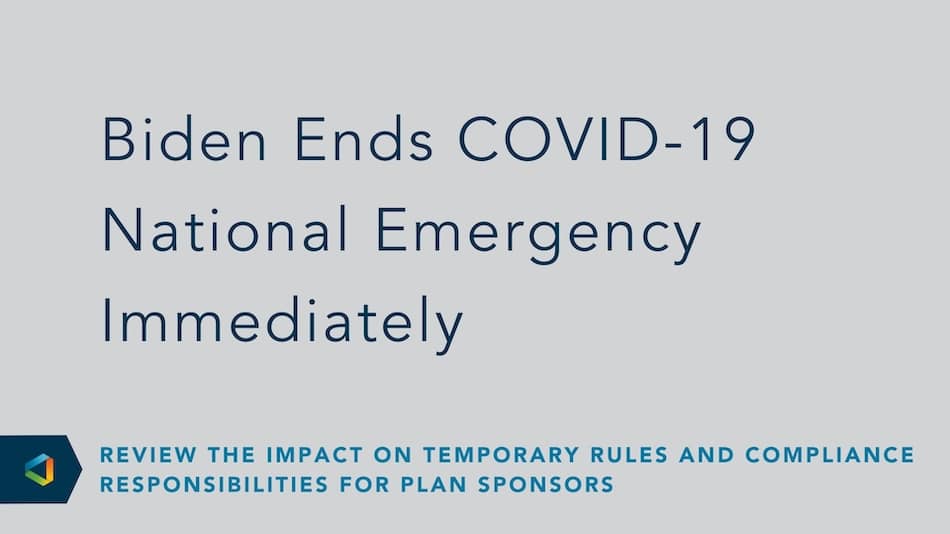Compliance Confidence
Update: President Biden Issues Executive Orders on Health Care, COVID-19 and More
Update: President Biden Issues Executive Orders on Health Care, COVID-19 and More
The activity continues: signing 25 Executive Orders (EO’s) in the first week of his presidency, President Biden confirms that he’s looking for change. An additional 27 memorandums round out the executive actions in the first week.
The EO’s cover a range of topics but the top four categories are COVID-19, economic recovery, racial justice or equity, and climate change. A few other categories, like health care and immigration, round out the list.
It’s important to understand what an Executive Order is and can do. The President’s Executive Order privilege, as authorized by the Constitution, allows the President to issue federal directives to the agencies that are governed by the Executive Branch, e.g., Treasury, Department of Health and Human Services (HHS), Department of Labor (DOL), etc. or provide an interpretation of policy. It does not have force of law but directs agencies on how to carry out or enforce the current law or manage resources. These Executive orders often result in new or revised regulations from the affected agency(ies).
A few of these orders impact employee benefits, workers, or health care, in general. Some of the orders directly reverse President Trump’s previous EO’s and some are new actions.
Strengthening Medicaid and the Affordable Care Act - EO 14009 (1/20/21/pub. 2/2/21)
- Policy Interpretation:“It is the policy of my Administration to protect and strengthen Medicaid and the ACA and to make high-quality healthcare accessible and affordable for every American.”
- Agency Directive: Instructs the Secretary of HHS to consider establishing a Special Enrollment Period for uninsured and under-insured Americans, over 30 million people, to seek coverage through the Federally Facilitated Marketplace.
- Notice of Proposed Rulemaking (9/28/20) – Secretaries of HHS, Treasury, and Labor, along with any other department heads with authority related to Medicaid or the Affordable Care Act (ACA), shall review all existing regulations, order, guidance, documents, policies, and agency actions immediately to determine if any are inconsistent with this policy interpretation and, subsequently, determine whether to suspend, revise, rescind any such actions, take actions to fully enforce the policy or propose new rules. Specifically, they must examine:
- policies or practices that may undermine protections for people with pre-existing conditions, including complications related to COVID-19, under the ACA;
- demonstrations and waivers, as well as demonstration and waiver policies that may reduce coverage under or otherwise undermine Medicaid or the ACA;
- policies or practices that may undermine the Health Insurance Marketplace or the individual, small group, or large group markets for health insurance in the United States;
- policies or practices that may present unnecessary barriers to individuals and families attempting to access Medicaid or ACA coverage, including for mid-year enrollment; and
- policies or practices that may reduce the affordability of coverage or financial assistance for coverage, including for dependents.
Further, this order revokes the following EO’s:
- EO 13765, Minimizing the Economic Burden of the Patient Protection and Affordable Care Act Pending Repeal (1/20/17) - instructs regulatory agencies to make every effort possible to delay, change, or eliminate any provisions of the ACA that imposes a “cost, fee, penalty or regulatory burden.”
- EO 13813, Promoting Healthcare Choice and Competition Across the United States (10/12/17) - modifies the Affordable Care Act (ACA) by requesting information on the feasibility of expanding association health plans (AHPs), short-term limited duration insurance and health reimbursement arrangements (HRAs) and taking action to implement these enhancements
UPDATE from the Center for Medicare and Medicaid Services (CMS) – January 28, 2021:
- A new special enrollment period (SEP) is available in the Marketplaces that use HealthCare.gov, i.e. 36 states
- A new open enrollment window begins February 15, 2021 and continues through May 15, 2021 (previous open enrollment ended
- All eligible consumers newly applying or updating an existing application may
- This SEP is available through HealthCare.gov directly, the Marketplace call center, or direct enrollment channels, like an agent or broker
- Consumers will have 30 days after they submit their application to choose a plan
- Current enrollees will be able to change to any available plan in their area without restriction to the same level of coverage as their current plan
Economic Relief Related to the COVID-19 Pandemic EO 14002 (1/22/21, pub. 1/27/21)
- Purpose: To further assist Individuals, families, small businesses, and state, local, tribal, and territorial governments affected by the national pandemic and remove barriers to programs funded in whole or in part by the Federal Government.
- Agency Directive: Instructs all executive departments to identify actions they can take within existing authorities to address the economic crisis and consider actions that facilitate better use of data and other means to improve access and remove unnecessary barriers. Further, the agencies should prioritize actions that provide the greatest relief.
Protecting Worker Health and Safety EO 13999 (1/21/21, pub. 1/26/21)
- Purpose: To reduce the risk that workers may contract COVID-19. “That will require issuing science-based guidance to help keep workers safe from COVID-19 exposure, including with respect to mask-wearing; partnering with State and local governments to better protect public employees; enforcing worker health and safety requirements; and pushing for additional resources to help employers protect employees.”
- Agency Directive: The Secretary of Labor, consistent with applicable law, shall, with regard to health care workers and other essential workers:
- issue, within two weeks, revised guidance to employers on workplace safety during the COVID-19 pandemic;
- consider whether any emergency temporary standards on COVID-19, including the wearing of masks in the workplace, are necessary, and, if so, issue them by March 15, 2021;
- review the enforcement efforts of the Occupational Safety and Health Administration (OSHA) related to COVID-19 and identify any short-, medium-, and long-term changes that could be made to better protect workers and ensure equity in enforcement;
- launch a national program to focus OSHA enforcement efforts related to COVID-19 on violations that put the largest number of workers at serious risk or are contrary to anti-retaliation principles; and
- coordinate with the Department of Labor's Office of Public Affairs and Office of Public Engagement and all regional OSHA offices to conduct, consistent with applicable law, a multilingual outreach campaign to inform workers and their representatives of their rights under applicable law. This campaign shall include engagement with labor unions, community organizations, and industries and place a special emphasis on communities hit hardest by the pandemic,
- for other categories of workers, coordinate with States to ensure workers are adequately protected.
Promoting COVID-19 Safety in Domestic and International Travel EO 13998 (1/21/21, pub. 1/26/21)
- Policy: “Science-based public health measures are critical to preventing the spread of coronavirus disease 2019 (COVID-19) by travelers within the United States and those who enter the country from abroad.”
- Agency Directive: The Secretaries of Labor, HHS, Transportation, FSS, Homeland Security, TSA and US Coast Guard shall take immediate action, to the extent appropriate and consistent with the applicable law, to require masks to be worn in compliance with CDC guidelines in or on (a) airports; (b) commercial aircraft; (c) trains; (d) public maritime vessels, including ferries; (e) intercity bus services; and (f) all forms of public transportation. The heads of agencies may make categorical or case-by-case exceptions to policies to the extent that doing so is necessary or required by law.
Actions may not preempt State, local, Tribal, or territorial laws that are more protective than those required here.
Action to Implement Additional Public Health Measures for Domestic Travel – requires Secretaries of HHS and Homeland Security, in conjunction with the Administrator of the TSA, Commandant of the Coast Guard and the CDC, to recommend how they may impose additional public health measures for domestic travel. The order further requires the implementation of these measures to be issued in consultation with State, local, tribal, territorial officials, industry and union representatives from the travel sector, and consumer representatives.
- Policy: “To the extent feasible, travelers seeking to enter the United States from a foreign country shall be required to provide proof of recent negative COVID-19 test prior to entry and to comply with other applicable CDC guidelines concerning international travel, including recommended periods of self-quarantine or self-isolation after entry into the United States.”
Agency Directive: The Secretaries of HHS, through the Director of CDC, and in coordination with the Secretaries of Transportation and Homeland Security, to, within 14 days, assess the CDC order of January 12, 2021, regarding the requirement of a negative COVID-19 test and to take any further appropriate regulatory action consistent with CDC guidelines and applicable laws. These actions include specificity around the timing and types of tests, additional testing requirements prior to departure, proof of test results, feasibility of other public protective health measures, especially for those coming from areas where tests are inaccessible, and measures to detect fraud.
Similar action and guidance applies to land travel, sea travel, International Certificates of Vaccination or Prophylaxis (ICVPs) and corresponding electronic versions of ICVPs.
Preventing and Combating Discrimination on the Basis of Gender Identity or Sexual Orientation EO 13988 (1/20/21, pub.1/25/21)
- Policy: “Every person should be treated with respect and dignity and should be able to live without fear, no matter who they are or whom they love. Children should be able to learn without worrying about whether they will be denied access to the restroom, the locker room, or school sports. Adults should be able to earn a living and pursue a vocation knowing that they will not be fired, demoted, or mistreated because of whom they go home to or because how they dress does not conform to sex-based stereotypes. People should be able to access healthcare and secure a roof over their heads without being subjected to sex discrimination. All persons should receive equal treatment under the law, no matter their gender identity or sexual orientation… It is the policy of my Administration to prevent and combat discrimination on the basis of gender identity or sexual orientation and to fully enforce Title VII and other laws that prohibit discrimination on the basis of gender identity or sexual orientation. It is also the policy of my Administration to address overlapping forms of discrimination.”
- Agency Directive: The head of each agency shall review all existing orders, regulations, guidance documents, policies, and programs to determine consistency with the policy and consider whether any revisions, suspensions, or rescissions are necessary. Additionally, they will identify any new actions needed to fulfill the policy. Within 100 days of the order, each agency head shall develop a plan to carry out its findings and recommended actions.
Next Steps
The Departments will seek to address these Executive Orders and Memorandums within the scope of the law and their agency authority. These regulatory timelines are typically shorter than drafting and voting in a new law. Proposed, interim, and final rules by the regulatory agencies will provide the guidance for implementation and are all posted to the public at www.federalregister.gov. Each rule invites public comments giving individuals and groups the opportunity to help shape the rules.
Separate action by lawmakers may provide additional funding, broader scope, or reinforcement of these actions in the near future. We will continue to monitor developments in the interim, and what this may mean to each customers, their employees and their benefit plans. Stayed tuned for more information.




